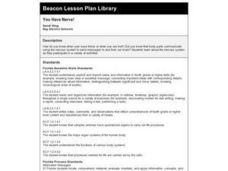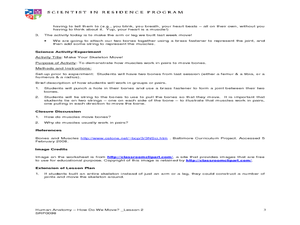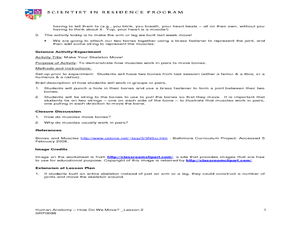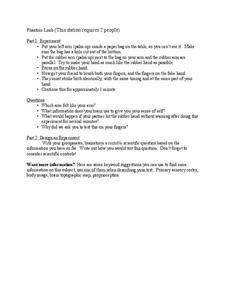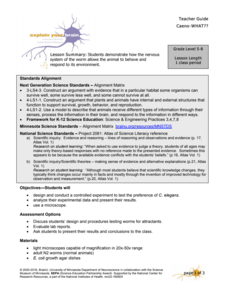Curated OER
The Nervous System
Students investigate the nervous system. In this anatomy lesson, students identify and define vocabulary related to the nervous system. Students role play the parts of a nervous system and perform an experiment measuring and...
Curated OER
Your Five Senses
Students identify the five senses. In this biology lesson, students participate in an experiment and use their five senses to identify various substances.
Curated OER
Chapter 1: The Science of Biology
Provide young biologists with everything they need to excel in the study of lymphatics, the nervous system, hormones, cellular division, and more! Pupils utilize the workbook, complete with end-of-chapter assessment worksheets, to...
University of Minnesota
Makes Me Sweat
Never let them see you sweat ... unless you can't help it! Scholars design an experiment to determine the effects of stress on the body. They monitor sweat production under different conditions and relate the response to the function of...
Curated OER
The Sense of Hearing
Students study the cycle of how we listen and hear our own speech. They examine sound waves, and the role of the nervous system in hearing. They investigate the cues besides lipreading that deaf people rely on for comprehension.
University of Minnesota
Mindflex Activity
Control a ball with your mind! Using a headset with an electrode, learners adjust the movement of a ball. They develop an experiment that tests the involvement of the central nervous system in controlling the ball. The activity helps to...
Curated OER
You Have Nerve!
Fourth graders investigate the nervous system and how it communicates messages to and from the brain.
Curated OER
Human Anatomy - How Do We Move?
Fifth graders discover how blood moves around the body. In this circulatory system lesson, 5th graders feel their pulse before and after exercise. Students count their heart rate. Students use the scientific method to record...
Curated OER
Human Anatomy- How Do We Move?
Students explore the human anatomy. In this respiratory system lesson, students conduct an experiment to simulate the capacity of human lungs.
Curated OER
Human Anatomy -- How Do We Move?
Young scholars create a model of the digestive system. In this human anatomy lesson the students examine features of the digestive system. The young scholars perform an experiment.
University of Minnesota
Phantom Limb
A phantom of neuroscience may leave pupils perplexed as they engage in an experimental lesson that recreates a phantom limb scenario. After experiencing the phenomenon, they choose a scientific question to explore further.
Curated OER
Response to Stimuli
Students study the process of detection, coordination and response. In this biology lesson, students design an experiment to test stimuli response. They participate in a game-show style quiz after the activity.
Curated OER
Hand Sensitivity
Learners experiment with the sense of touch. In this tactile lesson, students determine the most sensitive area of the hand. Learners experiment by describing objects through touch only. Students compare the amount of sensory data...
University of Minnesota
Caeno-WHAT??
Can you feel that? Can you smell that? Since pupils can't ask worms about their sense of smell and touch, they design and complete an experiment to answer these questions. Individuals expose nematodes to different stimuli using their...
Curated OER
Opening Our Minds
Students discover the function of the brain. In this biology lesson plan, students participate in several experiments to demonstrate what part of the brain controls their movements. An example of an experiment is drawing with their...
Curated OER
The Effects of "Recreational" Drugs on the Development of Chick Embryos as a Model for Human Embryogenesis
Learners conduct experiments on fertilized chicken embryos to determine the possible developmental effects that various recreational drugs (caffeine, alcohol, nicotine, and aspirin) might have on them.
Curated OER
Memory/Physiology Lab Activity
Young scholars investigate the nervous system and how physical distractions influence mental performance. They work in pairs as a researcher and subject and memorize a series of words with no distractions. After repeating the list of...
Curated OER
The Effects of Alcohol and other Teratogens: A model using Zebrafish
Students investigate the interference of various drugs on an embryo through experimentation. This is an open-ended lab to allow students to see effects of various chemicals humans choose to put in their bodies and create questions they...
Curated OER
Lead Poisoning and Ceramic Dishes
Learners explore the amount of lead in ceramic plates through an experiment. Students determine if everyday dishware is leaching lead into food. They chart their results and discuss how much lead in ceramic dishware may cause lead...
Curated OER
Anatomy of the Brain
Students explore human anatomy by completing a quiz. In this brain instructional activity, students read assigned text which discusses the different elements of the human brain and how they are used in everyday experiences. Students...
Curated OER
The Effect of Math Anxiety on Cardiovascular Homeostasis
Students examine the effect stress due to test anxiety may have on the heart. As part of the experiment, students hypothesize, collect data, graph data, analyze data and formulate an understanding of their personal level of stress and...
Curated OER
What Makes Up An Artificial Satellite?
Young scholars discover the components of a satellite using analogies to humans in a class discussion and participate in an activity in which they construct a paper model of a satellites and experiment with different types of attitude...
Curated OER
Reflexes
Students experiment to explain how reflexes, nerve impulses travel to the brain.
Curated OER
This Stuff Makes Me Sick
Pupils participate in a lab showing the effects of pesticides on Lumbriculus variegatus. Several extensions and variations are also included in this lesson including one which relates the experiment to how pesticides enter our drinking...






